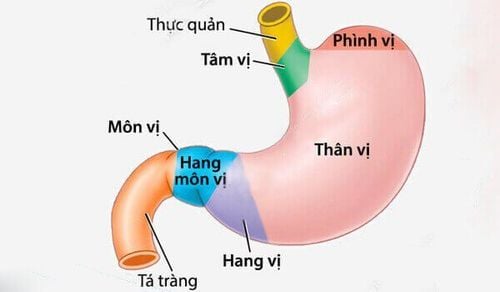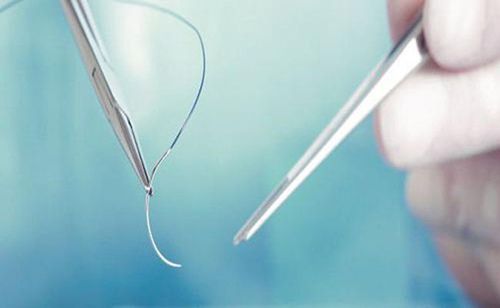This is an automatically translated article.
Laparoscopic gastrojejunostomy is an exploratory endoscopic method; At the same time, during endoscopic surgery, the microcolon connection surgery will be combined, the passage between the thick skin and the beginning of the jejunum will be combined.
1. When is laparoscopic gastrojejunostomy surgery indicated?
Surgery is performed when the path to the duodenum is blocked, possibly due to a tumor, or narrow ulcer,... or not allowing food to pass through the duodenum, possibly due to duodenal rupture,...
Patient The doctor will appoint laparoscopic gastrojejunostomy when the patient has the following symptoms:
Food does not enter the duodenum due to obstruction due to the patient having tumors in the antrum, duodenum, ampulla of Vater, pancreas. The path to the duodenum has poor circulation because the patient has had a total X-nerve ablation, pyloroplasty. The patient's body actively does not allow food to pass through the duodenum, closing the pylorus. Or the duodenal diverticulum is so large that it cannot be removed.

Chỉ định mổ nội soi khi xuất hiện khối u gây tắc nghẽn thức ăn ở hang vị
2. Contraindications for laparoscopic gastrojejunostomy?
General contraindications:
Patients with many diseases, severe malnutrition, weak body health. There is a tumor that has invaded the entire stomach area. The tumor has metastasized to many places. Patients with cardiovascular and respiratory diseases at the same time, cannot inflate the abdomen. The patient has undergone abdominal surgery many times.
3. Preparation before conducting laparoscopic gastrojejunostomy
Performers: Including a team of gastroenterology nurses with long-term experience in laparoscopic surgery, anesthesiologists and resuscitators. The patient will be under endotracheal anesthesia
Facilities : Laparoscopic surgery kit
Patient: Required to do tests before endoscopy to ensure safety
Perform basic tests: Formula test blood, biochemistry, coagulation, cardiopulmonary imaging, normal electrocardiogram,...
Gastroscopy aims to accurately diagnose the cause of obstruction. Contrast gastroscopy: To evaluate the patient's stomach shape and determine the degree of pyloric stenosis. Do additional abdominal CT-Scan to assess the lesion. Anesthesia before laparoscopy Wash the stomach before surgery.

Nội soi dạ dày tại Vinmec
Medical records: In accordance with the hospital's regulations, the patient completes administrative procedures before surgery including: medical records, minutes of consultation, pre-anesthesia examination, written consent to surgery .
Execution technique:
Posture: Lying head high, legs low. The monitor and devices are placed horizontally on the left shoulder of the patient. The patient lies in a position of head high, legs low at an angle of 150 - 300 (Trendelenburg position), legs at an angle of 900. The main screen and devices are placed horizontally at the patient's left shoulder position. The performer stands on the right side of the patient. Technique of making anastomosis: The doctor makes an anastomosis in front of the transverse mesocolon, connecting the jejunum with the anterior antrum with 2 layers. The length of the anastomosis is about 6cm, about 4cm from the pylorus - the lowest supporting part of the stomach. Open the stomach, open the intestine to stop bleeding well at the opening (by suturing, electrocautery...), the technician cleans the stomach before connecting. Stitch the posterior margin of the gastrostomy (except the posterior suture mucosa) to the posterior lacrimal fascia with a septum or a squeegee. Perform suture of the inner layer on the back of the mucosa, or the whole with a separate stitch or a squeeze, closed suture.

Tiến hành mổ nội soi nối dạ dày – hỗng tràng
After completing the laparoscopic gastro-jejunostomy, the patient continues to need further monitoring and treatment:
Fasting, parenteral nutrition. Use antibiotic therapy within 5 days. A nasogastric tube may be indicated for early withdrawal within 24-48 hours of surgery. Nourishing the body through the gastrointestinal tract soon after gastric bypass. Perform abdominal drainage if possible within 48 hours if the patient's abdomen is stable. Performing endoscopic gastro-jejunostomy is a combined endoscopic surgery method that requires highly skilled operators and modern equipment because of the complicated endoscopic method. Patients should choose large, reputable hospitals to ensure safety as well as the best level of success.
To register for examination and treatment at Vinmec International General Hospital, for detailed information and to book an appointment for medical examination and consultation, customers can call the hotlines of the hospitals or register for an online consultation with Vinmec International General Hospital HERE








